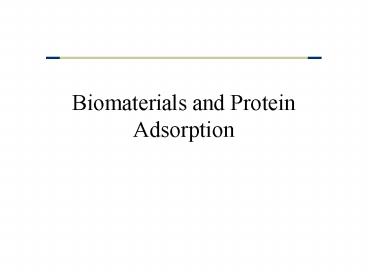Biomaterials and Protein Adsorption PowerPoint PPT Presentation
Title: Biomaterials and Protein Adsorption
1
Biomaterials and Protein Adsorption
2
Examples of Biomaterials
- Medical implants
- Contact lenses
- Drug delivery systems
- Scaffolding for tissue regeneration
3
Proteins are amphiphilic molecules in an aqueous
milieu
- Polypeptides are amphiphilic molecules
- BUT -- The human body is 90 water!
- SO hydrophobic regions of proteins seek refuge
in supramolecular configurations that minimize
their exposure to water
4
Hydrogen Bonding Depends on the
Electronegativities of the Donor and Receptor
Groups
- Blue hydrogen donors
- Red hydrogen acceptors
- Black non-hydrogen bonding
5
Proteins adhere to hydrophobic surfaces
t
- Foot Model of protein adhesion
- Self-propagating
- First step in the humoral response against
foreign materials in the body
6
Design of Biomaterials Surfaces
- Hydrophilicity inhibits protein adsorption,
however - Some cell adhesion may be desirable
- Compliance is a key consideration
- Solution? Polymers, of course!
s
7
Techniques for Coating Biomaterials
- Physisorption
- Adhesion to biomaterial surface is of hydrophobic
and/or electrostatic origin - Chemisorption
- Polymer is chemically attached to the surface,
usually via reaction of the surface with a
specific end-group on the polymer - Often referred to as a self-assembling
monolayer (SAM) - example an SH terminated polymer covalently
binds to a Au3 surface
8
Polymer Brushes
- A brush is formed when the spacing d between
end-grafted polymers is less than twice the Flory
radius, RF, where RF aN3/5 and a is
the monomer size
9
Fundamentals of Protein-Surface Interactions
- Large free energy gain associated with protein
adhesion to hydrophobic surfaces - Attraction due to long-range van der Waals
forces, as well as specific and hydrophobic
interactions, and the electrostatic double layer
(all short-range) - Repulsion due to steric and osmotic factors
(short range) - Proteins will stick if
- Ubare(0) lt kT
10
Steric and Osmotic Factors
- Atoms and molecules take up a finite amount of
space which cannot be occupied by other elements
i.e. they introduce an excluded volume - Dense packing, rotations, and/or rearrangements
may therefore not be energetically allowed i.e.
steric hindrance - Crowding leads to an increase in the internal
energy and thus the osmotic pressure
11
The Free Energy Profile of the Brush has Two
Minima
- a) brush potential, Ubrush(z)
- b) attractive primarily van der Waals
- potential UvdW(z)
- c) net interaction potential
12
Modes of Protein Adsorption
(I.) adsorption of proteins to the top boundary
of the polymer brush (II.) local compression of
the polymer brush by a strongly adsorbed
protein (III.) protein interpenetration into
the brush followed by the non- covalent
complexation of the protein and polymer
chain (IV.) adsorption of proteins to the
underlying biomaterial surface via
interpenetration with little disturbance of the
polymer brush
13
What do the The Primary and Secondary Minima
Correspond to?
Secondary minimum Uout Adsorption at the outer
brush surface
Primary minimum Uin adsorption at the solid
surface
14
Osmotic vs Entropic Forces
The brush thickness, L depends on a balance of
forces
Osmotic Force
Elastic Force
At Equilibrium
or
Brush thickness
where
Monomer volume fraction
Variables
So the corresponding force and free energy per
chain
And the corresponding osmotic pressure
15
Secondary Adsorption
Occurs when Uout lt -kT
- Since there is no energy barrier, it is only
possible to control Uout thermodynamically - Uout ? UvdW(L)
- Because penetration of the brush requires chain
compression, large proteins will preferentially
undergo secondary adsorption so long as UvdW(L) lt
-kT - For a rod-like protein (fibrinogen, e.g.) of
radius R and length H, suppression of secondary
adsorption may only be achieved if
Where A is the Hamaker constant, A 10-21 J for
proteins interacting with organic materials
16
Primary Adsorption
Occurs when Uin lt -kT
The presence of an energy barrier enables both
thermodynamic and kinetic control
When Rp ltlt L
There is negligible effect on ?
When Rp gtgt L
Approach to the surface results in compression of
the brush and an increase in osmotic pressure
where
and
Where ? is the width of the energy barrier and D
is the diffusion coefficient
The rate constant for adsorption
And the free energy barrier, U for primary
adsorption
Where Uads is the interaction potential of the
adsorbed protein at the bare surface
Finally
17
Methods for Counteracting Protein-Surface
Interaction with Polymer Coatings
- Dense polymer coatings (low s)
- Long polymer chains (large N)
Uout may be manipulated by varying N or s Uin is
primarily controlled by varying s
R a N
d a s
18
Poly(ethylene oxide) (PEO) in Biomaterials
- The most extensively used polymer for biomaterial
surface coatings, because - Completely water-soluble
- Creates an extensive H-bonding network
- Helical conformation
- Proven to be extremely protein resistant
- Capable of being functionalized for
ligand-receptor specificity - However
- Poor mechanical stability
- Protein adhesioin reported under certain
conditions

